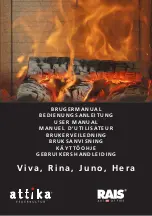
14
Combustion air
Pre-warmed air for combustion (secondary airflow). It must be adapted in every single
case. A strong chimney draught requires less supply of combustion air.
Maximum height of fire
wood
Tertiary airflow
is a constant supply of air that ensures
the stove burns more cleanly and, among
other things, reduces the burning
material’s content of tar and soot parti-
cles to the absolute minimum sizes.
With optimal burning you will see that the
glass and the combustion chamber will
burn completely cleanly and there will be
a minimal amount of ash left by the fire.
Overheating
Overheating occurs when you put too much wood in the stove or if the fire has too
much air. This can happen, for example, when the gaskets in the stove are not sealed
or the ash pan has not been closed properly.
In extreme cases, overheating can lead to a fire in the chimney. Overheating also
causes much wear on the stove, both to wearing parts and gaskets, glass, vermiculite
and the stove itself.
Closed Open
11
Chimney:
There must always be a chimney stack with a diameter of at least 15 cm. This is equivalent to
clearing of 175 cm
2
. Remember to ensure that the draught conditions are satisfactory and that
smoke does not inconvenience your neighbours.
If your chimney has a regulating damper, the draught can be regulated. Please note that the
damper must never be completely closed. There must always be at least 20 cm² of free passage
through the chimney.
In some cases, it can be an advantage on days when the wind is blowing strongly.
At nominal operation, the stove has been tested with a flue gas flow of 4.6 g/s and with flue gas
temperature of 265°C at a room temperature of 25°C.
Varde stoves are always equipped with a smoke guide plate. This ensures that the smoke’s path
to the chimney is as long as possible. This ensures that the smoke’s heat is released in your
home rather than in the open air outside. The smoke guide plate lies loosely in the stove’s
combustion chamber and you must ensure that the plate is pushed all the way back against the
combustion chamber’s rear plate.
Draught conditions
Ask the chimney inspector how to get the best draught from your chimney.
Chimney height
If required, refer to your chimney inspector, who will help you to set the correct height.
Condensation drain in the flue collar
Your stove is fitted with a cast iron flue collar from Varde Ovne. The flue collar is designed for a
flue pipe (chimney) with an inner diameter of 150 mm.
You can establish a condensate drain yourself, if your steel chimney is to be fitted in the stove’s
top outlet:
Make a hole in the bottom of the exterior grate (at the mark) using a small chisel or similar,
thus making the condensate drain yourself, if you need it.
Marking of condensate drain.
A condensate drain has
now been made.
Make an opening using chisel
or similar.






























